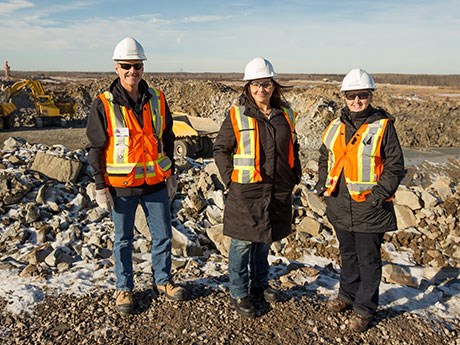All-in sustaining costs of $670 per ounce
Take a drive by New Gold’s Rainy River project, located 65 kilometres northwest of Fort Frances, Ontario, and you’ll see sure signs of movement towards its planned opening in 2017.
The construction workforce alone was at about 500 people just before Christmas. The company began hiring last fall and is slowly bringing the operational crew up from just over 100 at New Year’s to about 190 by March 31. By that time, the workforce will be almost 70 per cent local and over 30 per cent Aboriginal, said Grant Goddard, general manager of the Rainy River project.
“We’re in the midst of what we call Wave 1 of our recruiting and onboarding for our operations group,” Goddard said. “We’re growing fairly rapidly now.”
Once the mine opens, it will employ about 450 people, he said. Training will be provided in part through an agreement with Confederation College, which has a campus in Fort Frances.
“It’s very important to us as part of the way we operate our business that people will say, ‘We’re glad New Gold was here,’” he said. “We’re focused to the greatest extent possible on hiring locally, hiring from the Rainy River District, and hiring Aboriginal employees.”
Fort Frances itself sees the opening of the Rainy River Mine as an opportunity to inject new life into the town after its main employer, Resolute Forest Products, closed two years ago.
“With the closing of the paper mill, the community had two choices,” said Tannis Drysdale, economic development officer for the Rainy River Future Development Corporation. “One was to shrug our shoulders and pack up the downtown and say, ‘Let’s move on,’ or to say this is a great opportunity for a new start.”
Of course, the town chose “a new start” by preparing itself for New Gold and other future opportunities. Part of that is an incentive program for developers and individuals to encourage renewal within the city.
“Like many small towns, particularly those built around forestry or the railroad, there was a time when lots were really, really small,” Drysdale said. Rather than create completely new developments, the town prefers to tear down old houses and/or combine existing lots to build new housing. This infill approach keeps the town’s existing footprint – and municipal infrastructure – while essentially giving Fort Frances a facelift.
Drysdale said Fort Frances already has some new residents who are working at the mine, though likely the largest influx of new residents will come closer to the mine’s opening date. She said that the town is currently meeting goals set out in its economic development plan including those related to enquiries and sales in the new industrial park.
Several local companies including Onikaajigan Construction, Saulteaux Consulting & Engineering, and Tom Veert Construction are already working with New Gold during the construction phase. Thunder Bay-based companies are also benefiting, including TBT Engineering, Nordmin Engineering, Northwestern Ontario Industrial Medical and Rehabilitation Services, Tom Jones Construction, Actlabs, Payford Steel, Fastenal, and the Thunder Bay Port Authority, which handles incoming mine and mill equipment from Europe.
Once the mine starts production, it will be New Gold’s largest producer until its Blackwater project near Prince George, B.C. goes into production (now in permitting with no timeline in place for opening). In fact, the Rainy River project will account for approximately 40 per cent of New Gold’s production. The company anticipates processing 21,000 tonnes of ore daily yielding about 325,000 ounces of gold per year. Proven and probable mineral reserves are 3.8 million ounces of gold and 9.4 million ounces of silver with measured and indicated resources of 2.9 million and 10 million ounces respectively. The project is comprised of volcanogenic-style gold deposits situated within the Late Archean Wabigoon subprovince of Ontario.
Goddard said that the company spent about $3 million on further exploration of the project in 2015. This year, there will be some further exploration he said, though the focus will be on mine startup.
“Hopefully, as we get underground and do a little more drilling there, we find a few more ounces, but we’ll see what Mother Nature gives us,” Goddard said.
What makes the Rainy River project so attractive is that it will have a very low cost of production with all-in sustaining costs (AISC) of about $670 per ounce. Goddard cited proximity of infrastructure including road and power lines, the project’s acceptance into the province’s Industrial Electricity Incentive Program, and a relatively low-cost production profile as reasons for the low AISC, along with a considerable amount of silver by-product.


